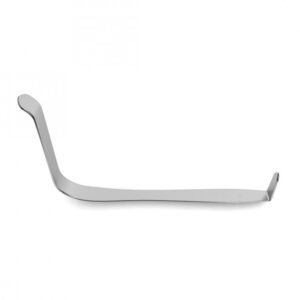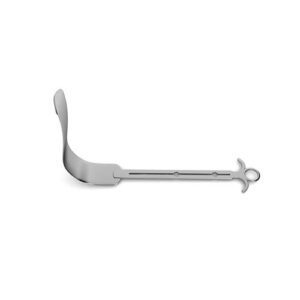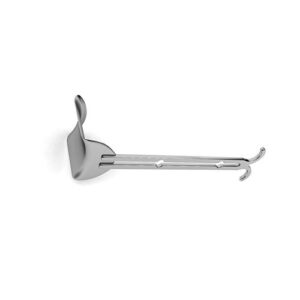| Name | Heiss (Holzheimer) Cross Action Retractor |
| Lead Time | 0-3 days |
| Specialty | General Instruments-Hooks & Retractors – Self-Retaining Retractors |
| Material Finish | Stainless Steel |
| Grade | Premium Operating Room |
| Units of Measurement | Each |
| Manufacturer | seemab surgical |
| Sterility | Non-Sterile |
| Usage | Reusable |
Heiss (Holzheimer) Cross Action Retractor
Heiss (Holzheimer) Cross Action Retractor
4×4 prongs, 4″ (10.2 cm)
Heiss (Holzheimer) Cross Action Retractor is a self-retaining retractor that contains claws that curve outward and is 4″ in length. If a small or shallow incision needs to be held open, especially in ophthalmology operations, this retractor can be held into place due to the ratchet mechanism that separates the two 4×4 prongs. According to the type of incision being held, sharp or blunt prongs are available.
SKU:
VI-01-533
Category: Hooks & Retractors
Description
Shipping & Delivery
Related products
Alm Retractor
Alm Retractor
4x4 prongs
Alm Retractor is a device used during general surgical procedures that involve retracting tissue in small areas of the body. This retractor features 4x4 prongs that are available in sharp or blunt points depending on the type of tissue being held. The instrument is also self-retaining due to a mechanism that allows the surgeon to keep it in a desired place once it has been inserted.
Cope Retractor
Double-ended, 6.0 mm & 11.0 mm, 7-1/8" (18.0 cm)
Cope Retractor is a double-ended surgical instrument primarily used to pull back skin or organs that may obstruct the operating area. The main features of this retractor are its different shaped blades. For example, one end contains a strongly curved blade with a lip. The other end, however, contains a sharp, right angle blade with a ridge on the tip.
Balfour Wide Center Blade
Balfour Wide Center Blade
for detachable balfour retractor systems
Balfour Wide Center Blade features a wide blade that comes in two different depths depending on the area that needs to be retracted. The basic purpose of this instrument is to keep the edges of an incision separate, such as those in the abdominal area. Furthermore, this center blade is specially designed for the detachable Balfour Retractor Systems.
Barsky Skin Hook
Knurled handle, 6" (15.2 cm), sharp
Barsky Skin Hook can be used in various medical procedures where skin or soft tissue needs to be maneuvered, such as procedures involving plastic surgery or ophthalmology. The knurled handle contributes to a better grip for the surgeon, and the hook at the end contains a sharp prong that can be single or double. The high quality stainless steel used to produce this instrument may help to prevent bacteria from adhering to its surface during an operation.
Deaver Retractor – Flat Handle, Curved End
Deaver Retractor - Flat Handle, Curved End
flat handle, flexible, curved end
Deaver Retractor is flexible and includes a flat handle with a curved end. This uniquely shaped retractor allows the surgeon to have a more comfortable hold while positioning it during surgeries. These surgeries typically involve areas in the deep abdominal or chest cavity. The flexible nature of the slightly curved blade may help to prevent injury to the organs area being held. In order to accommodate certain cases, this instrument is offered in various blade widths and lengths.
Balfour Standard Center Blade – For Fixed System
Balfour Supra-Pubic Center Blades
Center Blades
for balfour retractor systems w/ fixed side blade
Balfour Supra-Pubic Center Blades can be useful during procedures such as a Suprapubic cystotomy. When the bladder is retracted, this instrument provides the surgeon with a larger viewing area so that the procedure can be conducted. This blade is presented in two different sizes.
Glass Abdominal Retractor
Abdominal Retractor
6" (15.2 cm) x 3-1/4" (8.3 cm), 9-3/4" (24.5 cm)
B.E. Glass Abdominal Retractor contains a flexible blade with a strong curve that is affixed to a handle for gripping purposes. This type of retractor is intended to be used during surgeries that require retracting or exposing the organs in order to provide better accessibility for the surgeon.













